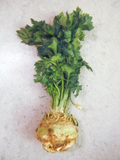Celeriac
Celeriac (Apium graveolens var. rapaceum), also known as celery root, turnip-rooted celery or knob celery, is a variety of celery cultivated for its edible roots, hypocotyl, and shoots. It is a biennial plant that belongs to the family Apiaceae, which includes carrots, parsley, and parsnips. Celeriac is notable for its distinctive flavor, which resembles that of celery stalks, and its versatility in cooking. It is used in a variety of culinary dishes, ranging from salads and soups to roasted vegetable medleys.
Description[edit]
Celeriac has a large, globular root that is typically rough and brownish on the outside with a creamy white interior. The plant's green leaves and stalks resemble those of common celery but are more robust. Celeriac roots can vary significantly in size but generally weigh about 1-2 kilograms (2-4 pounds). The plant thrives in temperate climates and is harvested when its root reaches a desirable size, usually in the late summer or fall.
Nutritional Value[edit]
Celeriac is low in calories but rich in dietary fiber, which is beneficial for digestive health. It also contains essential vitamins and minerals, including Vitamin K, Vitamin C, phosphorus, potassium, and manganese. These nutrients contribute to bone health, immune system support, and overall well-being.
Culinary Uses[edit]
Celeriac can be consumed raw or cooked. When raw, it is often peeled, then grated or thinly sliced and added to salads for a crisp, refreshing texture. Cooked celeriac can be boiled, mashed, roasted, or used as a flavoring in soups and stews. Its subtle, celery-like taste pairs well with a variety of foods, including meats, other vegetables, and legumes.
Cultivation[edit]
Celeriac prefers a well-drained soil rich in organic matter. It requires a consistent supply of moisture throughout the growing season and benefits from mulching to retain soil moisture and control weeds. The plant is relatively slow-growing and may take up to 200 days to reach harvest size. Celeriac is more tolerant of cold temperatures than common celery, making it a suitable crop for cooler climates.
Health Benefits[edit]
In addition to its nutritional value, celeriac has been associated with several health benefits. Its high fiber content can aid in weight management and promote a healthy gut microbiome. The antioxidants present in celeriac, such as Vitamin C, may help reduce inflammation and lower the risk of chronic diseases.
History[edit]
The cultivation of celeriac dates back to the 17th century in Europe, where it gradually became popular as a root vegetable. Its use has since spread globally, and it is now featured in various cuisines around the world.
See Also[edit]
Celeriac[edit]
Ad. Transform your life with W8MD's Budget GLP-1 injections from $75


W8MD offers a medical weight loss program to lose weight in Philadelphia. Our physician-supervised medical weight loss provides:
- Weight loss injections in NYC (generic and brand names):
- Zepbound / Mounjaro, Wegovy / Ozempic, Saxenda
- Most insurances accepted or discounted self-pay rates. We will obtain insurance prior authorizations if needed.
- Generic GLP1 weight loss injections from $75 for the starting dose.
- Also offer prescription weight loss medications including Phentermine, Qsymia, Diethylpropion, Contrave etc.
NYC weight loss doctor appointmentsNYC weight loss doctor appointments
Start your NYC weight loss journey today at our NYC medical weight loss and Philadelphia medical weight loss clinics.
- Call 718-946-5500 to lose weight in NYC or for medical weight loss in Philadelphia 215-676-2334.
- Tags:NYC medical weight loss, Philadelphia lose weight Zepbound NYC, Budget GLP1 weight loss injections, Wegovy Philadelphia, Wegovy NYC, Philadelphia medical weight loss, Brookly weight loss and Wegovy NYC
|
WikiMD's Wellness Encyclopedia |
| Let Food Be Thy Medicine Medicine Thy Food - Hippocrates |
Medical Disclaimer: WikiMD is not a substitute for professional medical advice. The information on WikiMD is provided as an information resource only, may be incorrect, outdated or misleading, and is not to be used or relied on for any diagnostic or treatment purposes. Please consult your health care provider before making any healthcare decisions or for guidance about a specific medical condition. WikiMD expressly disclaims responsibility, and shall have no liability, for any damages, loss, injury, or liability whatsoever suffered as a result of your reliance on the information contained in this site. By visiting this site you agree to the foregoing terms and conditions, which may from time to time be changed or supplemented by WikiMD. If you do not agree to the foregoing terms and conditions, you should not enter or use this site. See full disclaimer.
Credits:Most images are courtesy of Wikimedia commons, and templates, categories Wikipedia, licensed under CC BY SA or similar.
Translate this page: - East Asian
中文,
日本,
한국어,
South Asian
हिन्दी,
தமிழ்,
తెలుగు,
Urdu,
ಕನ್ನಡ,
Southeast Asian
Indonesian,
Vietnamese,
Thai,
မြန်မာဘာသာ,
বাংলা
European
español,
Deutsch,
français,
Greek,
português do Brasil,
polski,
română,
русский,
Nederlands,
norsk,
svenska,
suomi,
Italian
Middle Eastern & African
عربى,
Turkish,
Persian,
Hebrew,
Afrikaans,
isiZulu,
Kiswahili,
Other
Bulgarian,
Hungarian,
Czech,
Swedish,
മലയാളം,
मराठी,
ਪੰਜਾਬੀ,
ગુજરાતી,
Portuguese,
Ukrainian


